Adrian Simcox Does Not Have a Horse:
A Visit with Marcy Campbell and Corinna Luyken
 March 26th, 2018 by jules
March 26th, 2018 by jules
(Click to enlarge spread)
Dear 7-Imp readers, I try not to do that thing where I write about a book you can’t yet retrieve from a library or bookstore shelf, but I have an opportunity to talk to debut author Marcy Campbell and illustrator Corinna Luyken about Adrian Simcox Does Not Have a Horse (Dial), which will be on shelves in August. And I have an opportunity to show you some of the art from it. And I didn’t want to pass up those opportunities, because I’ve seen an early copy of this book and think it’s worth sharing.
This is a story about compassion, class (in more ways than one), perspective, truth, and the stories we tell ourselves. Chloe does not believe her classmate Adrian Simcox when he tells everyone he has a horse. She knows that someone who gets free lunches at school can’t afford to board and take care of a horse. How could he pay for it? Where would he even keep a horse? Chloe gets increasingly angry as Adrian continues to talk about his horse. She wants him to tell the truth and even calls him out on the playground.
I don’t want to ruin this read for you when it’s finally on shelves, so I’ll stop there. But suffice it to say that Chloe has a revelation when she visits Adrian in the yard of his home (on a walk her wise mother insists they take). This is a promising debut for Marcy, and what Corinna does in these illustrations is a sight to see — particularly, what she does with negative space, which you will read about below.
Let’s get to it. Here are Marcy and Corinna — in their own words. (Thanks to both of them for visiting and to Corinna for sharing preliminary images and some of her process work in this post, too.)
Corinna: My first thought, after reading Marcy’s text, was: This is such a beautiful story! My second thought was: This will be so challenging to illustrate! The text had no art notes, leaving plenty of room for the illustrator to add her own vision to the story. This was one of the (many) things that I loved about it, but it also brought up some questions, the first being: Should I show the horse or not?
Before I said yes to the project, I spent some time thinking, drawing, and think-drawing. How do you show something that may or may not exist?
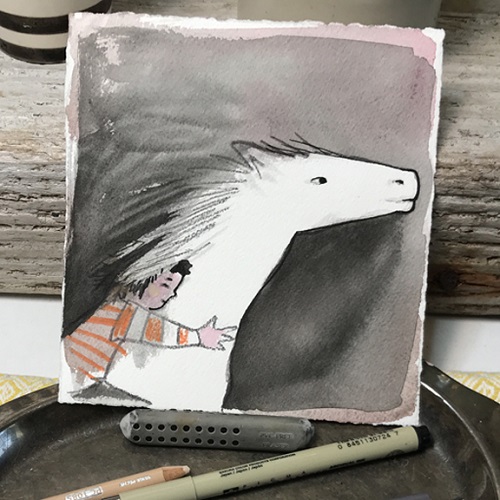
Some of my early think-drawings were about the environment that might be around Adrian. For a while, I thought that the horse could be there — in peeling paint, on the side of his house. A porch light could be the horse’s eye. Or perhaps the horse could be in the yard — in the shape of a tree or a bush. But this all seemed a little too obvious.
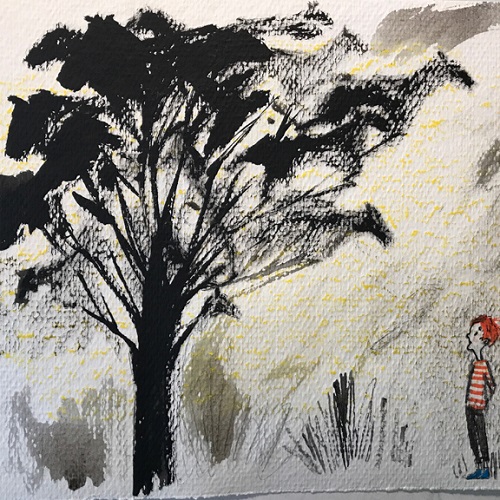
During this early stage, I also experimented with materials. The final art in the book is made with watercolor, ink, colored pencil, and graphite. But in addition to more traditional brushes, I used Popsicle sticks and paintbrushes that I altered (with scissors) to create many of the textures.
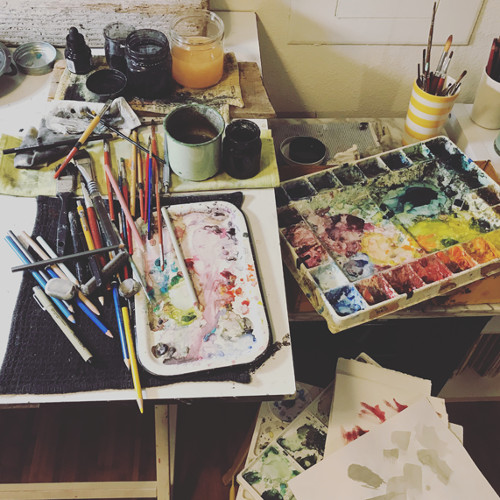
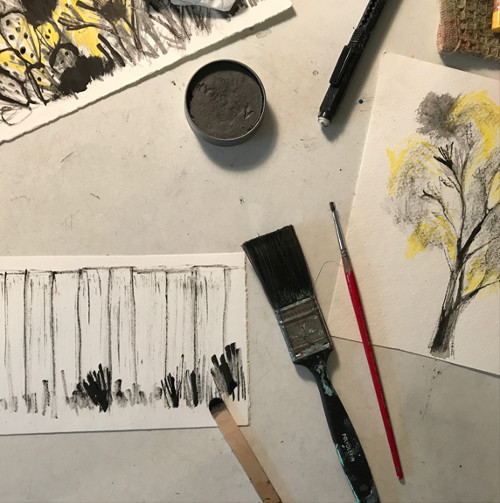
To help with the project, I also ordered two new studio assistants.
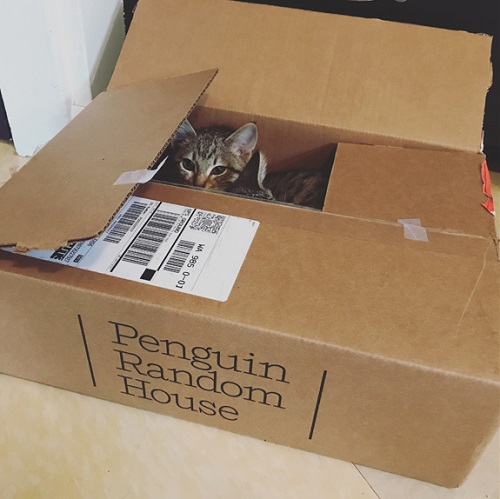
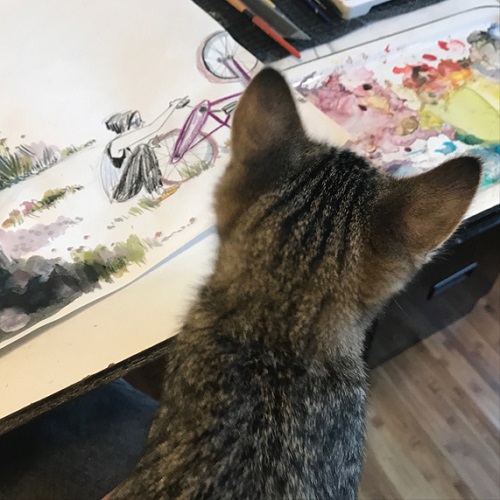
In Marcy’s original manuscript, the horse was golden with a white mane. So, I spent some time thinking about what might be golden or yellow in Adrian’s yard.
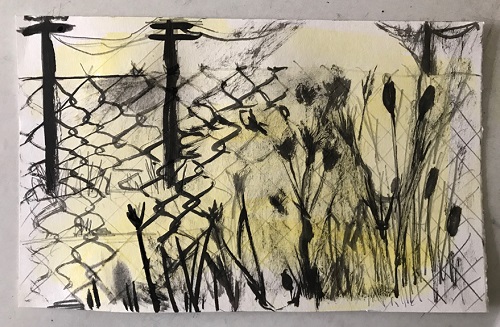
It was while experimenting with grasses and fences, both metal and wood, that I started to see how the pattern in a fence could hold a shape of its own.
From there, I realized that using negative space was the perfect solution. The horse could simultaneously exist and not exist, depending on how you look at it, which led me to this image:

And then this one:

Once I arrived at this image, I knew I had found a way into the story. At that point, I sent sketches to the agent that Marcy and I share (Steven Malk at Writers House) and he sent them on to Namrata Tripathi and Lily Malcom at Dial (who, coincidentally, were my editor and art director for The Book of Mistakes).
After that, it was a process of figuring out how to show a horse in slightly different ways on different spreads. Figuring out if/how to show the horse was challenging, but the actual drawing and painting of the horse (or lack of horse) after that was so much fun!
Marcy: I cried my eyes out [when I saw Corinna’s artwork] — with happy tears! It feels odd saying this — and I think I’m probably in the minority among children’s authors — but I had no preconceived notions about how the characters would look. I had no illustration notes in the text. Of course, I was already quite familiar with Corinna’s The Book of Mistakes, so I knew she was going to do something incredible, but I was still just speechless seeing this book come to life so beautifully. The first thing I noticed was Adrian’s red hair, and I thought he was perfect! It just seemed to suit him. But beyond the physical characteristics, what Corinna does so expertly is capture emotion, whether in the slant of an eyebrow or the droop of a shoulder. There’s a lot of emotion in this book, and I think, even without the words, a reader can follow Adrian and Chloe’s path toward friendship via Corinna’s illustrations.
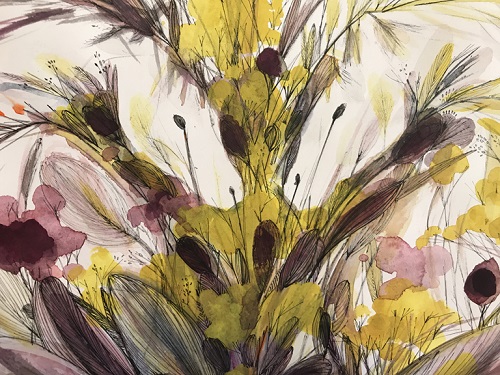
Corinna: (Spoiler alert!) Because there are hidden horse(s) on many pages, I did a lot of experimentation throughout the entire process of making this book. There was one page, in particular, that was difficult to figure out. I redrew it many times, trying to find the right balance between obvious and not-obvious-enough.
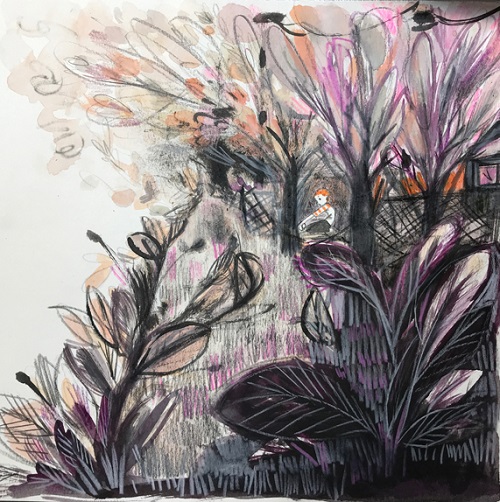
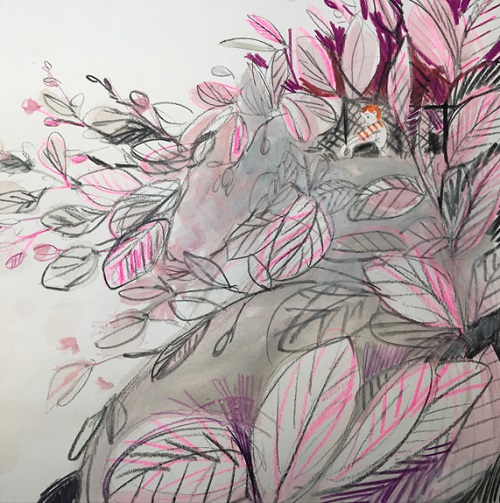


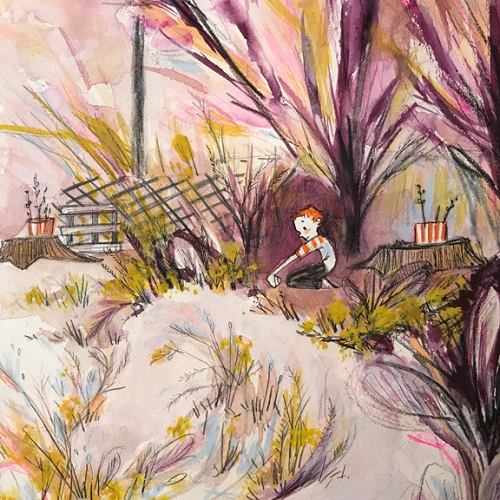
But for the horse(s) on the last two pages and cover, I had a pretty clear idea of where I was going from the beginning. It was more a question of figuring out the composition and expressions for Chloe and Adrian.


As I got further into the book though, I began to wonder if it made more sense for the horse to be white with a golden mane instead of golden with a white mane. Marcy graciously agreed to the change, and so the horse became white. This gave me even more room to play with the negative space.
Marcy: When my editor, Namrata Tripathi, told me what Corinna had planned in terms of the negative space, I was happy to make that change. It worked so well, and I know kids are going to have fun looking for those hidden horses.

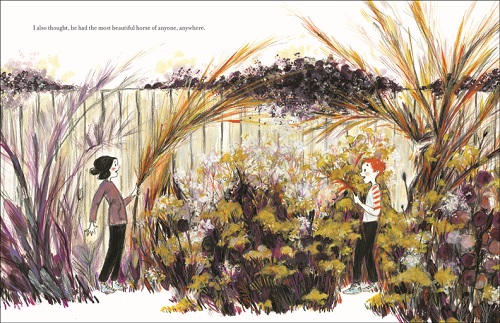

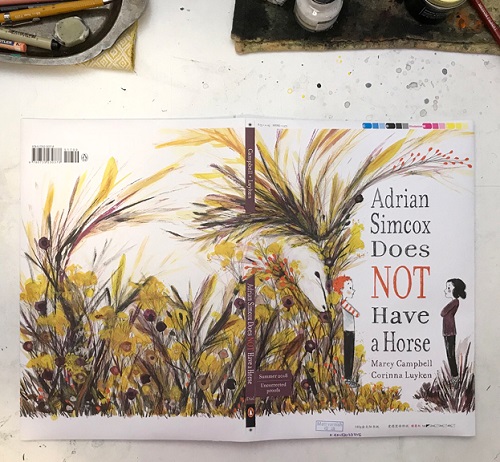
[Publishing this] feels like a dream. I’ve been writing since I was a kid, but I didn’t have the encouragement to pursue writing as a career until I was almost out of college (shout-out to Dr. Marjorie Dorner at Winona State University). She planted the seed, but I thought it was “too late” to change career paths. (Ha! I was 22.) I worked in public relations and marketing but never stopped writing stories. Eventually, I went back to school and earned a graduate degree in creative writing and published short stories, essays, and the occasional poem — but all for adults.
My goal was to publish an adult literary novel, and I spent years writing two of them and gathering literally hundreds of rejections (though many of those were very encouraging), all while keeping a separate file of picture book ideas. Like many children’s authors, I really tuned into the children’s book world after having my own kids, and I started studying the books on their shelves. When I needed a break from revising my novel-in-progress, I turned to my picture book ideas file. And one day, I came across a line that read: “boy says he has a horse, but girl doesn’t believe him.” I knew a boy in my elementary school who told a lot of lies, and one of them involved a horse. His similarities to Adrian end there, however. This boy may have had a horse in the country, for all I know, but I knew where he lived and there was no horse there. I remember getting quite angry, as a little girl, that he lied about things.

‘Because I know! Adrian Simcox does NOT have a horse!’
Adrian Simcox gets the free lunch at school. His shoes have holes.
Kelsey told me her cousin has a horse, and it’s super expensive.
He can’t take care of a horse.”
(Click spread to enlarge)
That one fragment of an idea would become, “Adrian Simcox Does NOT Have a Horse.” I sent it to an agent I’d “met” over Twitter to get feedback, and she was kind enough to point out my text left no room at all for an illustrator. I’d described everything! I wrote another draft, then decided to send to the agent who represented the author and illustrator of the last picture book I fell in love with, which was Last Stop on Market Street. That agent was Steven Malk at Writers House. Things happened quickly after that — signing with Steve, the book going to auction, selling to Dial.
It seemed like, overnight, I was a children’s author. I did everything backwards. It was only after the book sold that I joined SCBWI, attended their national conference in NYC, and really began to figure out this kidlit world. The amazing and wonderful thing is that it all feels so right. I remember sitting in the audience during the keynote speeches at the conference and feeling like this was exactly where I was supposed to be. I’ve never felt so sure about my place in the writing world. It just took awhile to get here.
I didn’t set out to [address class in this book]. All I knew was that I was going to try and tell the story of these two kids and their disagreement over a horse! But once I started writing, I started to ask myself why Adrian was lying.
I know that class can be an uncomfortable topic to discuss. When I was a kid, I heard bits and pieces about my dad’s family and how much they struggled. My parents were blue-collar and worked multiple jobs, but they really didn’t talk about money, except to say when we couldn’t afford something I might have wanted. That said, I certainly noticed differences between our family and that of some of my friends who lived in big, beautiful houses. The kids in my class came from a variety of economic backgrounds. It was important to me and my husband that our kids have that same experience.
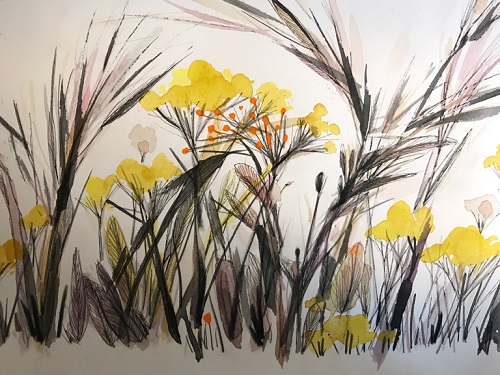
(Click to enlarge)
Our neighborhood elementary school (which my son attends, and my daughter attended until she hopped up to middle school this year) is very economically diverse. More than 70% of the kids qualify for free or reduced lunch. As a very active volunteer in the school, I see and hear a lot of things that make my heart break for these kids. As just one example, Ohio (where we live) has been hit very hard by the opioid epidemic, and that is tearing families apart.
There have been times when my kids have gotten upset about a real, or perceived, slight from a classmate, and I’ve had to help them take a step back to consider the possible cause of that behavior. In some cases, I might be aware that the family is going through a rough time. Kids want to be “right.” They want to be vindicated. But it’s important to remember that we really can never know what another person might be going through, so we need to keep an open mind and try to be understanding. It’s so hard, for all of us — adults included. I didn’t just write this book for kids. I wrote it for myself (and for the young me that had a little bit of Chloe in her), as a reminder that it’s always good to be a bit kinder than we have to be. We don’t get many details about Adrian Simcox’s life, but it’s clear he’s able to use his imagination to transcend any reality. Once Chloe starts to see the world through Adrian’s imagination, she realizes that the thrill of vindication is not long-lasting, but friendship has the potential to be.
The book, to me, is more about kindness and understanding than it is, specifically, about class. Empathy cuts across all kinds of barriers, class being just one of them.
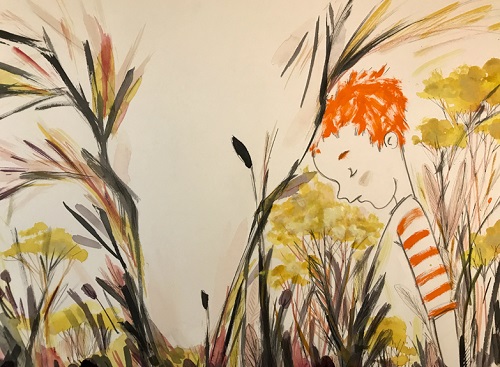
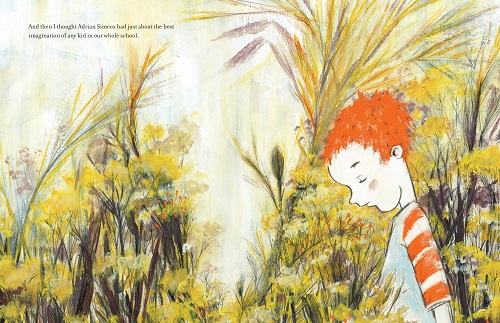
the best imagination of any kid in our whole school.”
(Click each to enlarge)
Corinna: Early on, I also drew an image of Chloe pulling up some grasses. It was a simple drawing, but it felt important. As I make more books, I’m starting to realize that this is a necessary part of my process. It helps to start out very rough — and to play. And then certain images will emerge, ones that have an energy to them. They may not look like much to someone else, but they are a key for me. They unlock the rest of the story. This image of Chloe was like that. In retrospect, it makes sense that if I was going to use grasses to create negative space on the final pages, I would need to use them elsewhere in the book as well.
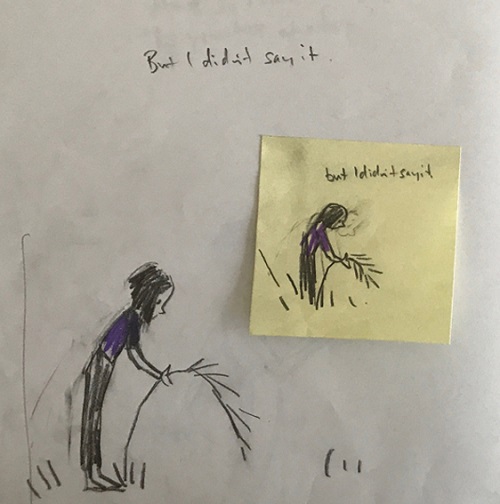

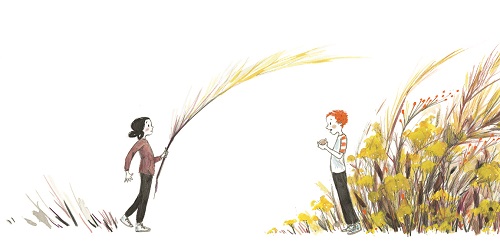
And Adrian started talking about his horse ‘with a white coat and golden mane and
the biggest, brownest eyes of any horse, anywhere. …'”
(Click to enlarge)
Adrian reminded me of a few kids I knew growing up, and I felt a really strong connection to him as soon as I read the story. He changed a little bit from those early sketches, but for me the core of who he was stayed the same.
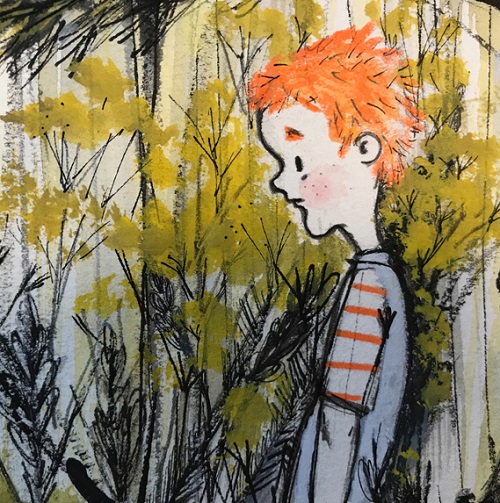


It took me a little longer for me to find my way into Chloe’s character. But once I started asking questions about her, and trying to understand her better, she began to emerge on paper.

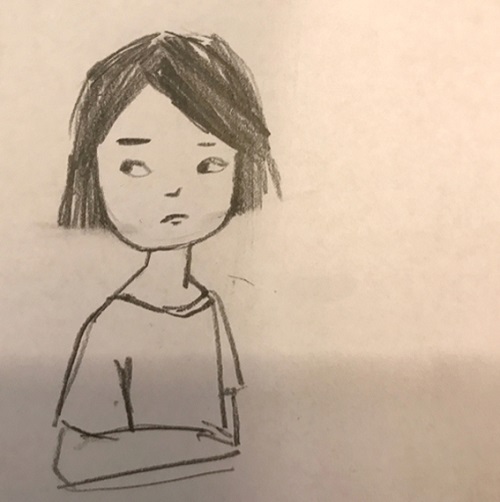

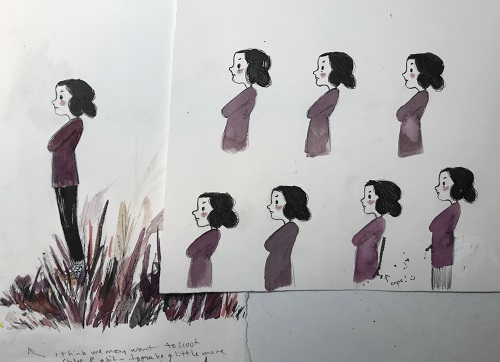
Another thing that changed toward the end of the process was the first page. Originally, I’d drawn Adrian with his back to the reader. This was partly because of the text (which eventually changed as well).
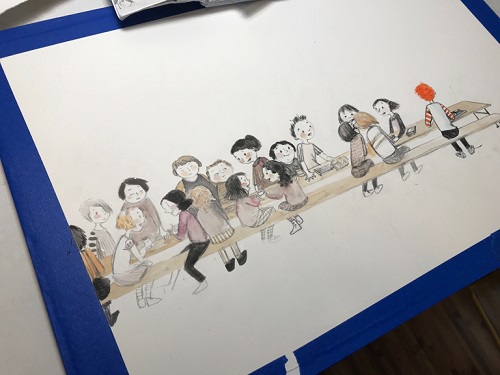
Most of the book had already gone off to proof when my editor and art director asked if I would turn Adrian around. I agreed, but only because Nami offered to pose as Adrian. I think she makes a pretty great Adrian. What do you think?


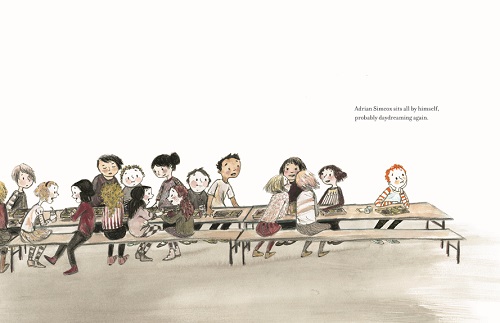
probably daydreaming again.”
(Click bottom two images to enlarge)
ADRIAN SIMCOX DOES NOT HAVE A HORSE. Text copyright © 2018 by Marcy Campbell. Illustrations copyright © 2018 by Corinna Luyken. All images here reproduced by permission of Corinna Luyken and the publisher, Dial Books for Young Readers, New York.
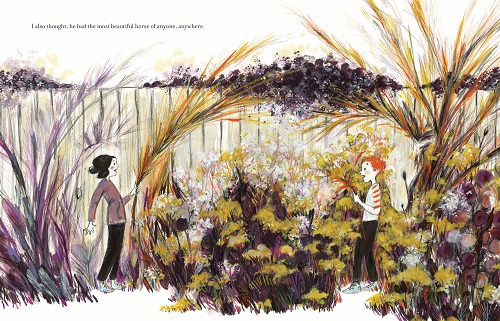

i am looking forward to seeing these warm, grasses – filled paintworks by Corinna Luyken as they soften the story of Adrian Simcox Does Not have A Horse, with kindness and understanding!
This looks so beautiful in both text and images — can’t wait to get my hands on a copy.
Wonderful interviews – love the insights of the author and illustrator. Can’t wait to read the book!
Had to come back and read in full. I love this book so much. It’s got more heart, depth and beauty – and it’s a real story – out there.
[…] Impossible Things” visits with Marcy Campbell & Corinna […]